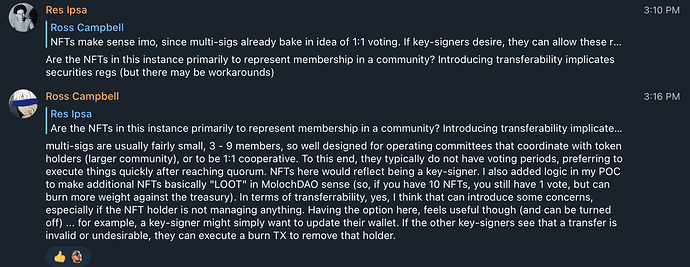Multi-signature wallets are the standard for on-chain coordination. They are simple to understand and are often the ‘pre DAO’ solution for many founders and communities experimenting with crypto.
Currently, Gnosis SAFE is the dominant solution. There is no competitive product being incubated, yet compelling, minimalist alternatives have been proposed by smart contract engineers, exA. It seems timely to expedite development of a ruthlessly minimal multi-sig pattern as an alternative to Gnosis SAFE, in the spirit of coopetition, and to provide this as a public good that can be incorporated by Gnosis and other crypto protocols interested in multi-sig patterns. The next wave of adoption, driven by migration of traditional corporate structures to mirroring their operations with smart contract and trust reduction tech will likely see multi-sigs as a bridge software, and LeXpunK can support and brand this solution to evangelize adoption by corporate boards and founders.
Some opinionated changes that can provide immediate value and contrast:
- Issuing NFTs to key-signers: This makes their roles composable with other smart contracts, and can also store discrete metadata related to each signer, such as disclosures and agreements.
- Ragequit: This capital exit pattern has been popularized by the Moloch DAO framework and at this point seems a necessary core feature of treasuries to protect minority interests, and as a failsafe security measure. Unlike Moloch, it makes sense for this feature to be toggled on/off through governance.
A contract design incorporating these features, built on the aforementioned multi-sig patterns, with the addition of the Solmate library to provide gas efficient NFT and asset transfers, can be reviewed here.
This proposal pitches LeXpunK to fund a core developer group to take this solution to market, starting with EVM, but also deploying in rust to support teams on Solana and Terra. As a simple contract pattern, adaptation to different languages should be far easier than porting over the existing SAFE design.
MVP looks like: (i) Audited Multi-Sig Contract, (ii) User Interface. The addition of code deference agreements curated for multi-sigs between LeXpunK and LexDAO would be a plus, and would further a lot of the great open source legal work done by these communities.
The ask: $100k to fund (i) smart contract audits (budget ~$40k), (ii) developer time (~$30k), (iii) lawyer time (~$30k). Audits will be the foremost priority, as this is the biggest impediment currently to launching an alternative multi-sig solution. The proposed developers are Kali, a team of legal engineers building DAO tools under LexDAO. Legal work is suggested for LeXpunK input.
Let me know your thoughts,
Ross



